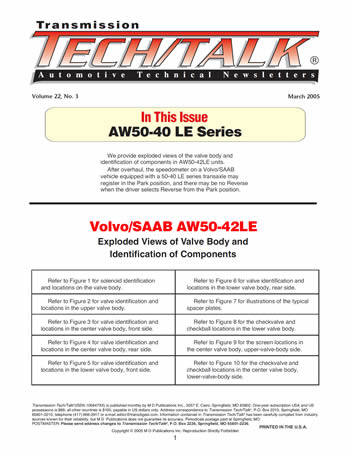This may be helpful for those with the no reverse condition. The symptoms are typically that all other gears work fine, but there is no reverse or significant slipping in reverse. If you put the front end on secure jack stands with the wheels free to turn, they may turn in reverse gear, but with little torque. (Obviously, for safety when doing this, put some type of chocks on the rear wheels. On cars where a cable-type parking brake only engages the rear wheels you can set that also.)
PART NUMBER NOTE: Sometime after the 1st Gen Parts Catalogs were issued, Chrysler later started adding a zero (0) to the front of the part numbers for some reason. So in searching for parts like those listed here you've got to do it with both the zero and without. Searches won't always get a hit if you just search without the zero.
This repair involves removing the valve body and replacing the old low/reverse accumulator cover (04431617 or 4431617) and O-ring with an updated one-piece cover that has a Viton sealing lip bonded to the bottom (04431617AB or 4431617AB, "Cover, Accumulator" part still available). You could also replace the the two sealing rings on the accumulator piston that ride in the bore (4446544 or 04446544 still available, Rockauto also often has them). Also inspect the piston & bore for damage (there are a couple of types of $40 repair kits from Sonnax, if so). The accumulator cover should be about $8 from Mopar dealers or ebay and the two sealing rings are about $4 each (though some sellers mark them way up). Note that different transmission mechanics and parts suppliers call this either a "cover" or a "cap," so in this post, I'll use both terms; they mean the same thing.
I assume that transmission mechanics know about this repair with info in their repair databases, but there doesn't seem to be much searchable information online, except for an obscure Chrysler "Satisfaction Notification," and a good post on a Jeep Wrangler forum. I have not been able to find a TSB on this for the Intrepid/LH cars, and it would have had to be released around 2005, when the problem was finally corrected. Transmission shops that know about this defect in the old accumulator cover also have a way to diagnose that fluid is leaking in the low/reverse piston bore. There are other internal problems that can cause no reverse, but this issue is quite likely, and obvioiusly much simpler to repair than pulling and rebuilding parts of the transmission.
Important: The repair may apply to all of the Chrysler Ultradrive transmissions before a certain date, but in particular the 42LE/A606 in the Intrepid/LH cars and the similar A604/41TE and the 42RLE (modified for rear drive).
This repair really should be a "How-To" here and on the Jeep and other forums, but it will show up in a Google search for the transmission numbers and "no reverse." Please add any comments or other info. While I wasn't able to find an LH car Technical Service Bulletin on this, there is a Chrysler "Customer Satisfaction Notification" posted online from October 2002 for the 41TE/ A604 transmission, which originally used the same defective low/reverse accumulator piston cover as in the 42LE/A606.
History:
Before 2005, the 42LE, 42RLE, and similar Chrysler transmissions used a two-piece cover/cap assembly for the low/reverse accumulator piston. It was made up of an aluminum cap (p/n 04431617, earlier just 4431617) and an O-ring (6501549 or 06501549) that fit in a groove in the cap. These are pictured (as below) in the 1st Gen Parts Catalog transmission section illustrations under "Accumulator Pistons & Springs." A similar illustration with the same two-piece cover and O-ring is in the 2004 Intrepid Parts Catalog.
The low/reverse accumulator is held in its bore in the transmission case with the cover and a snap ring shown (06501695 or 6501695), whereas the other two accumulator pistons (overdrive and underdrive) are loose and will fall out (along with their center springs) when the valve body is removed. (There is also another accumulator piston that is contained in the side of valve body.)
That O-ring on the accumulator cap was prone to breakage, causing high-pressure fluid leakage around it in reverse; so in 2002 Chysler issued "Customer Satisfaction Notification No. B27 Transaxle Low/Reverse Accumulator Cover" (pdf link below).
Notification quote: "Subject - The transaxle low/reverse accumulator cover O-ring on about 14,600 of the above vehicles [with 41TE transaxle] may become dislodged. This could cause the transaxle to slip in low and or/reverse."
However, because it could still recur after installing a new cap and O-Ring, this notification didn't really permanently solve the problem. However, it does usefully go through the whole processs of removing the valve body for access to the low/reverse accumulator piston. And by the way, it also likely applied to A LOT more than the 14,600 cars listed.
Below is a link to a page where a guy helpfully posted the Chrysler notification. His page also has many Dodge Neon TSBs (it had the 41TE transmission). I've also attached a copy of the pdf below. :
DaimlerChrysler
Customer Satisfaction Notification No. B27 Transaxle Low/Reverse Accumulator Cover, October 2002
Sometime around 2004-2005, a one-piece replacement cap (04431617AB) with an integral bonded Viton lower half (with sealing lip) was released to solve the problem. This part is still available through Mopar dealers and sometimes on ebay, and there are also aftermarket versions from the transmission parts suppliers.
When they did this cap update, Chrysler may have issued TSBs for every car that had the old (possibly leaking) low/reverse accumulator caps, especially as a follow-up to the previous Customer Satisfaction Notification. However, when I checked a while back I wasn't able to find one for the Intrepid on the Alldata database, so it may not exist. If anyone has a TSB title/number for this fix on any Chrysler cars, please post it. It would have been around 2005.
Below are the Mopar parts catalog Illustrations, showing the substitution.
(As I mentioned I've labeled it a "cover" but it is correctly "Cap, Accumulator" in the Parts Catalog) Second Illustration also shows the other accumulator pistons for comparison (no caps, and loose in the bores).
![Image]()
![Image]()
A good very good post on this repair from 2015 with photos of the old and new cap is at the link below to the Jeep Wrangler Forum. In this case, even the snap ring had broken, and the poster discusses the Sonnax kit available if there is any bore damage. I've have not seen this repair covered anywhere else online. So thanks very much to Weirdracin on the Wrangler Forum.
42RLE Slipping in Reverse sometimes - possible solution

 www.wranglerforum.com
---------------------
www.wranglerforum.com
---------------------
Attachment below of the linked Dodge Neon TSB on the original problem with the cap O-ring failing:
DaimlerChrysler
Customer Satisfaction Notification No. B27 Transaxle Low/Reverse Accumulator Cover, October 2002
28-B27-02.pdf :
PART NUMBER NOTE: Sometime after the 1st Gen Parts Catalogs were issued, Chrysler later started adding a zero (0) to the front of the part numbers for some reason. So in searching for parts like those listed here you've got to do it with both the zero and without. Searches won't always get a hit if you just search without the zero.
This repair involves removing the valve body and replacing the old low/reverse accumulator cover (04431617 or 4431617) and O-ring with an updated one-piece cover that has a Viton sealing lip bonded to the bottom (04431617AB or 4431617AB, "Cover, Accumulator" part still available). You could also replace the the two sealing rings on the accumulator piston that ride in the bore (4446544 or 04446544 still available, Rockauto also often has them). Also inspect the piston & bore for damage (there are a couple of types of $40 repair kits from Sonnax, if so). The accumulator cover should be about $8 from Mopar dealers or ebay and the two sealing rings are about $4 each (though some sellers mark them way up). Note that different transmission mechanics and parts suppliers call this either a "cover" or a "cap," so in this post, I'll use both terms; they mean the same thing.
I assume that transmission mechanics know about this repair with info in their repair databases, but there doesn't seem to be much searchable information online, except for an obscure Chrysler "Satisfaction Notification," and a good post on a Jeep Wrangler forum. I have not been able to find a TSB on this for the Intrepid/LH cars, and it would have had to be released around 2005, when the problem was finally corrected. Transmission shops that know about this defect in the old accumulator cover also have a way to diagnose that fluid is leaking in the low/reverse piston bore. There are other internal problems that can cause no reverse, but this issue is quite likely, and obvioiusly much simpler to repair than pulling and rebuilding parts of the transmission.
Important: The repair may apply to all of the Chrysler Ultradrive transmissions before a certain date, but in particular the 42LE/A606 in the Intrepid/LH cars and the similar A604/41TE and the 42RLE (modified for rear drive).
This repair really should be a "How-To" here and on the Jeep and other forums, but it will show up in a Google search for the transmission numbers and "no reverse." Please add any comments or other info. While I wasn't able to find an LH car Technical Service Bulletin on this, there is a Chrysler "Customer Satisfaction Notification" posted online from October 2002 for the 41TE/ A604 transmission, which originally used the same defective low/reverse accumulator piston cover as in the 42LE/A606.
History:
Before 2005, the 42LE, 42RLE, and similar Chrysler transmissions used a two-piece cover/cap assembly for the low/reverse accumulator piston. It was made up of an aluminum cap (p/n 04431617, earlier just 4431617) and an O-ring (6501549 or 06501549) that fit in a groove in the cap. These are pictured (as below) in the 1st Gen Parts Catalog transmission section illustrations under "Accumulator Pistons & Springs." A similar illustration with the same two-piece cover and O-ring is in the 2004 Intrepid Parts Catalog.
The low/reverse accumulator is held in its bore in the transmission case with the cover and a snap ring shown (06501695 or 6501695), whereas the other two accumulator pistons (overdrive and underdrive) are loose and will fall out (along with their center springs) when the valve body is removed. (There is also another accumulator piston that is contained in the side of valve body.)
That O-ring on the accumulator cap was prone to breakage, causing high-pressure fluid leakage around it in reverse; so in 2002 Chysler issued "Customer Satisfaction Notification No. B27 Transaxle Low/Reverse Accumulator Cover" (pdf link below).
Notification quote: "Subject - The transaxle low/reverse accumulator cover O-ring on about 14,600 of the above vehicles [with 41TE transaxle] may become dislodged. This could cause the transaxle to slip in low and or/reverse."
However, because it could still recur after installing a new cap and O-Ring, this notification didn't really permanently solve the problem. However, it does usefully go through the whole processs of removing the valve body for access to the low/reverse accumulator piston. And by the way, it also likely applied to A LOT more than the 14,600 cars listed.
Below is a link to a page where a guy helpfully posted the Chrysler notification. His page also has many Dodge Neon TSBs (it had the 41TE transmission). I've also attached a copy of the pdf below. :
DaimlerChrysler
Customer Satisfaction Notification No. B27 Transaxle Low/Reverse Accumulator Cover, October 2002
Sometime around 2004-2005, a one-piece replacement cap (04431617AB) with an integral bonded Viton lower half (with sealing lip) was released to solve the problem. This part is still available through Mopar dealers and sometimes on ebay, and there are also aftermarket versions from the transmission parts suppliers.
When they did this cap update, Chrysler may have issued TSBs for every car that had the old (possibly leaking) low/reverse accumulator caps, especially as a follow-up to the previous Customer Satisfaction Notification. However, when I checked a while back I wasn't able to find one for the Intrepid on the Alldata database, so it may not exist. If anyone has a TSB title/number for this fix on any Chrysler cars, please post it. It would have been around 2005.
Below are the Mopar parts catalog Illustrations, showing the substitution.
(As I mentioned I've labeled it a "cover" but it is correctly "Cap, Accumulator" in the Parts Catalog) Second Illustration also shows the other accumulator pistons for comparison (no caps, and loose in the bores).
A good very good post on this repair from 2015 with photos of the old and new cap is at the link below to the Jeep Wrangler Forum. In this case, even the snap ring had broken, and the poster discusses the Sonnax kit available if there is any bore damage. I've have not seen this repair covered anywhere else online. So thanks very much to Weirdracin on the Wrangler Forum.
42RLE Slipping in Reverse sometimes - possible solution

42RLE Slipping in Reverse sometimes - possible solution
So my 03 jeep has been having a problem of slipping in reverse, but in first it would grab fine, but every now and then when warm it would have a small shutter on attempts to take off rapidly. Dropping the valve body and check the 1st/rev accumulator valve that is in the main case about where...
Attachment below of the linked Dodge Neon TSB on the original problem with the cap O-ring failing:
DaimlerChrysler
Customer Satisfaction Notification No. B27 Transaxle Low/Reverse Accumulator Cover, October 2002
28-B27-02.pdf :







